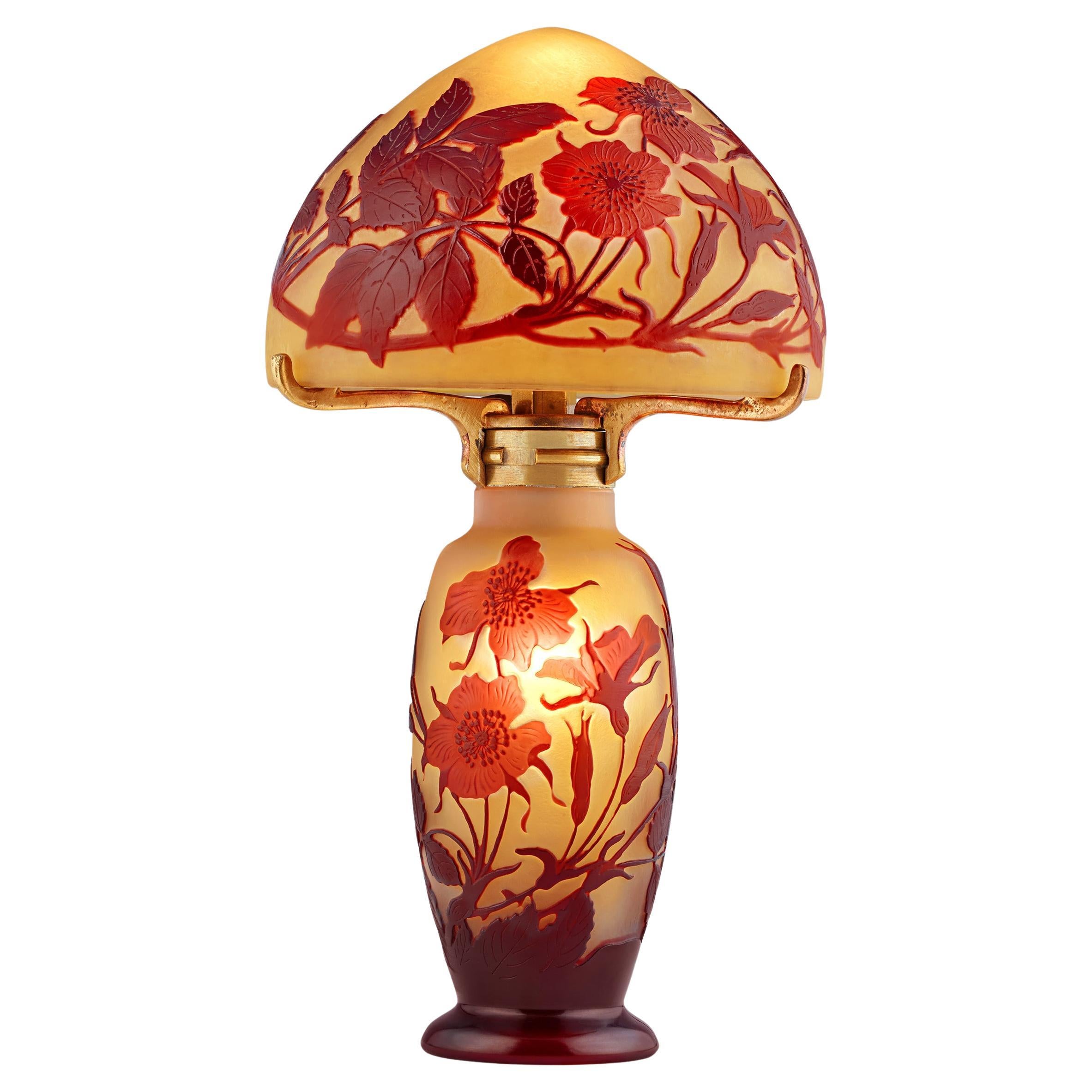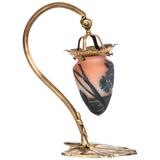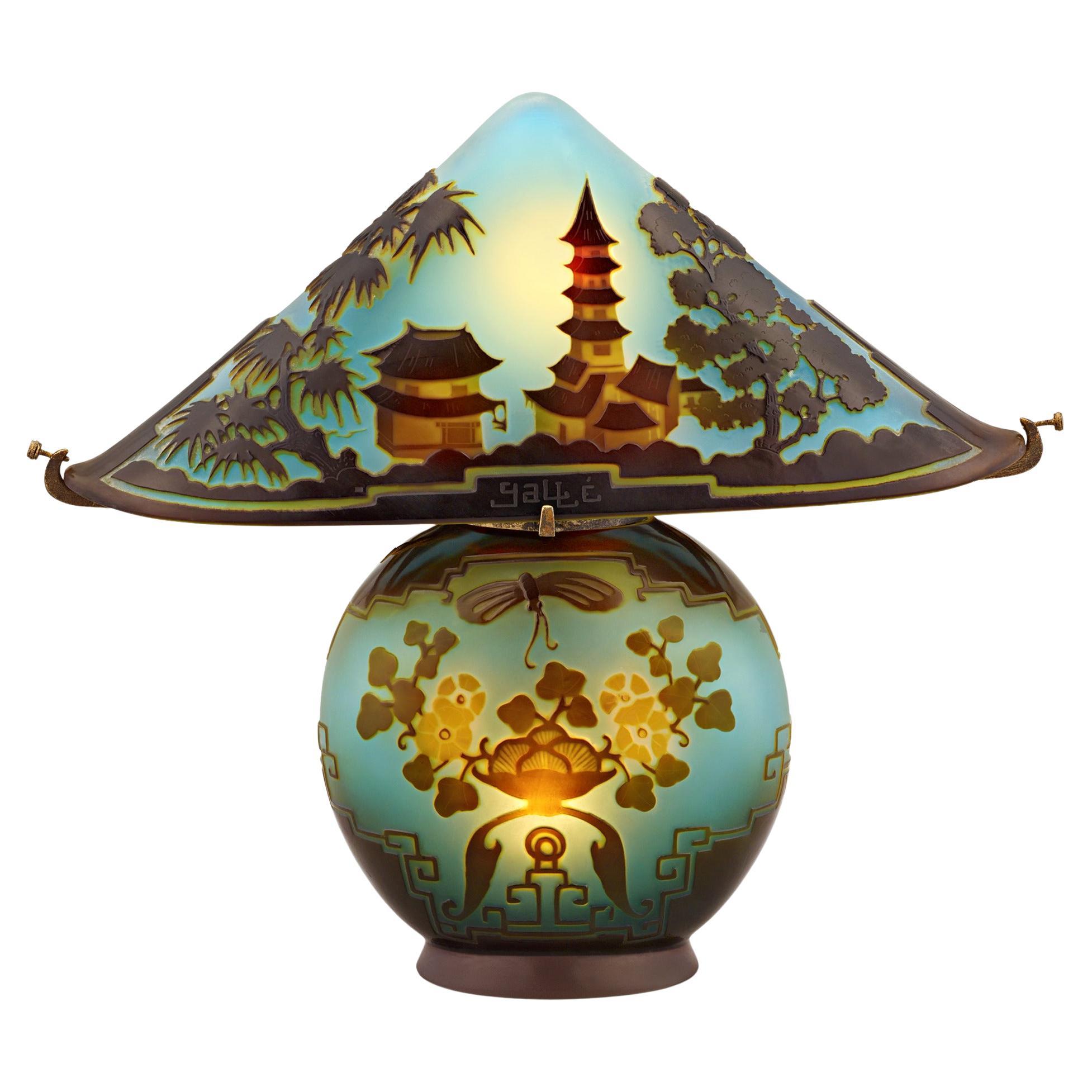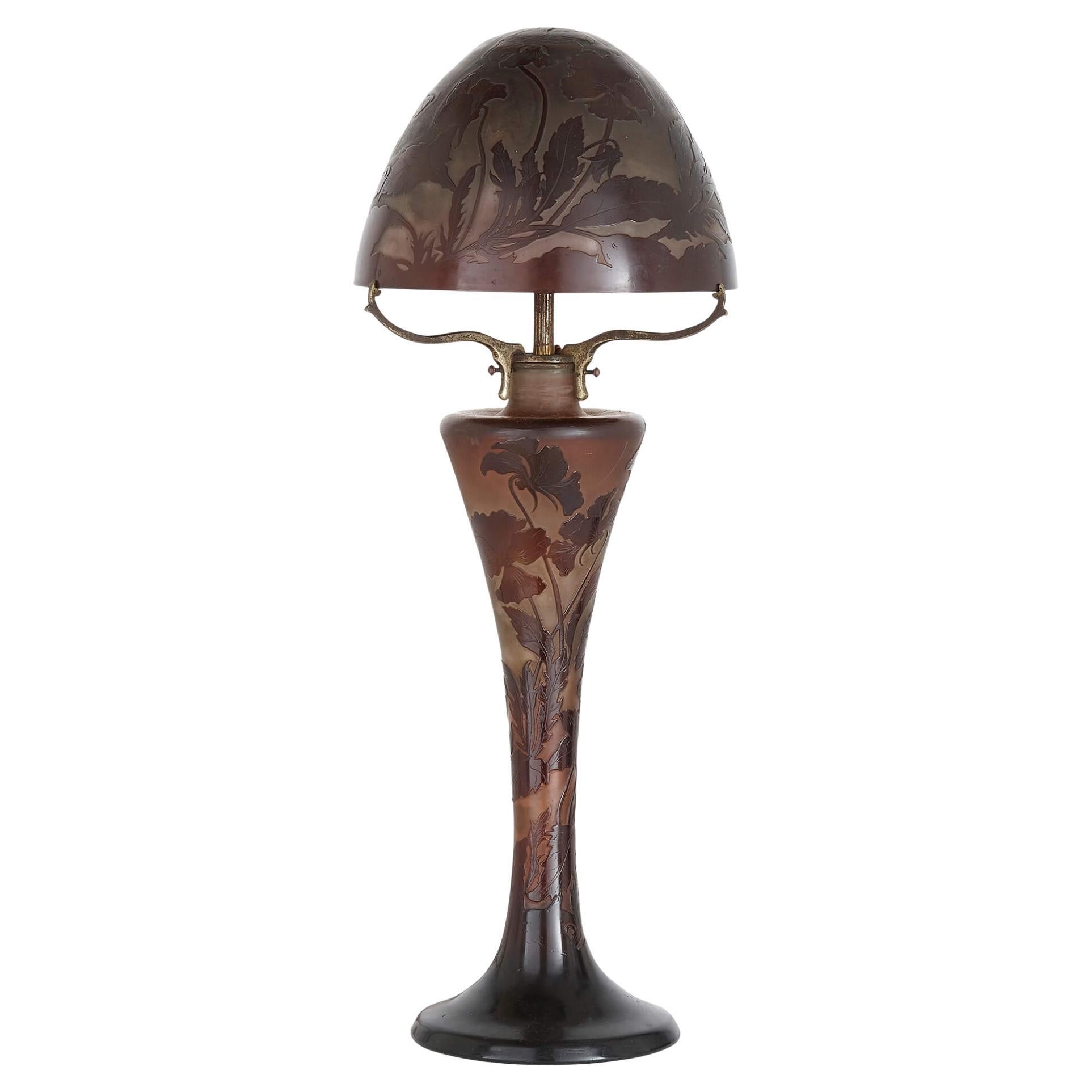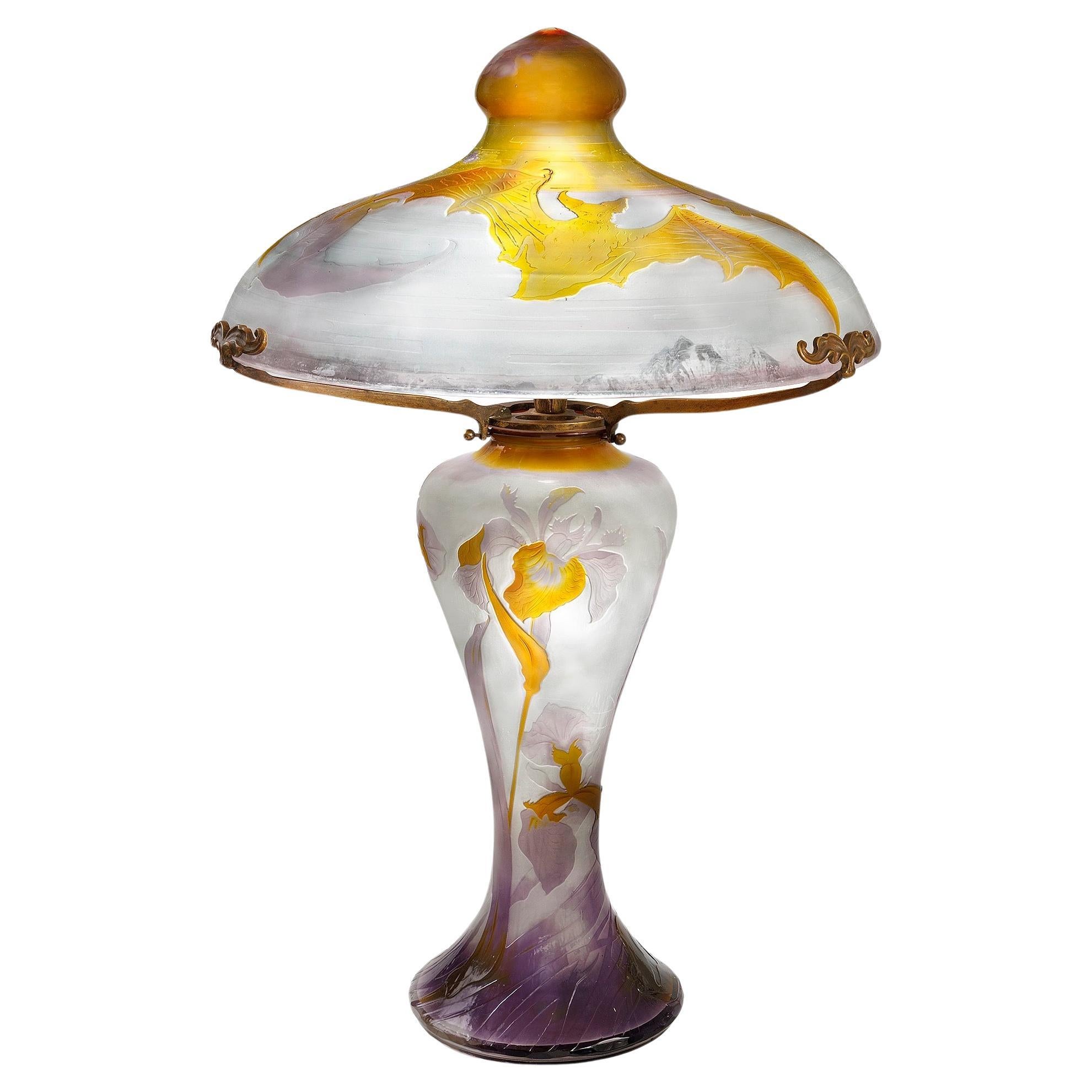Items Similar to Émile GALLE (1846-1904) "Paysage Vosgien" Glass Lamp circa 1900
Want more images or videos?
Request additional images or videos from the seller
1 of 10
Émile GALLE (1846-1904) "Paysage Vosgien" Glass Lamp circa 1900
About the Item
Émile GALLE (1846-1904) "Paysage Vosgien"
A multilayer glass lamp by Gallé
With an etched decor of a green and blue Vosgien landscape on the foot and of flying eagles on the lampshade, on a yellow background.
Two lights gilded bronze mount.
Signed "Gallé" on both elements.
Circa 1900
H 13.78 in. D 9.84 in.
Bibliography: Alastair Duncan et Georges de Bartha : "Glass by Gallé", Thames and Hud-son, 1984, modèle reproduit page 154.
Émile Gallé was born in Nancy on 4 May 1846, the only son of Charles Gallé (1818-1902) and Fanny Reinemer (1828-1891), who had a crystal and porcelain business in Nancy. After a period of apprenticeship in various European cities, Weimar and Meisenthal among oth-ers, Émile Gallé was associated with his father’s business of trading and decoration of earthenware and glassware in 1867. He represented his father at the Universal Exhibition of 1867 in Paris where he obtained an honorable mention for glassware and at the Exposition universal and international of 1872 in Lyon where he obtained a gold medal in the class 33 (porcelain and crystals). He married in 1875, Henriette Grimm (1848-1914), daughter of a pastor of Bischwiller (Alsace), with whom he had four daughters.
In 1877, Émile Gallé took over the family business and extended his activities to the cabinet-office in 1885. Already noticed at the Exposition de la Terre et du Verre in 1884, Émile Gallé was devoted to the Universal Exhibition in Paris in 1889 by three awards for his paintings, glassware and furniture (including a Grand Prix for his glassware). At this occasion, Gallé was made an officer of the Legion of Honor. Since then, Gallé has been intensively developing its technical and aesthetic research on glass work, a field in which it develops and creates new manufacturing processes. His glassworks were designed in Meisenthal until 1894, when Gallé opened a crystal factory that was set on fire on 29 May 1894 in his company in Nancy. His research led in 1898 to the filing of two patents, for "a kind of decoration and patina on crystal" and "a kind of marquetry of glasses and crystals".
His work, with multiple references, expresses the diversity of interests of Émile Gallé where nature plays a dominant role, but not exclusive. Artist but also botanist, Gallé was elected secretary of the Central Society of Horticulture of Nancy in 1877.
His patriotic and political commitments found their most successful form at the Universal Exhibitions of Paris in 1889 and 1900 with pieces such as the table "The Rhine" (which claims the return of an Alsace-Lorraine united to France) or spectacular installations like "Les sept cruches de Marjolaine" (in favor of the rehabilitation of Dreyfus). In 1898, Gallé was a founding member and treasurer of the Ligue des Droits de l'Homme et du Citoyen in Nancy and, the following year, a founding member of the Université populaire de Nancy. Dreyfusard of the first hour, he dedicated to the cause of Captain Dreyfus many talking glassware (which include a quote engraved on the glass), such as the vase Black Men, the chalice.
Involved very early in the renewal of the decorative arts, Émile Gallé disseminated, in his French but also English and German works, quality series pieces, thanks to the industriali-zation of his production. He opened sales depots in Frankfurt (1894) and London (1901), but his main dealer was Marcelin Daigueperce in Paris (1879) and his son Albert Daigue-perce in 1896.
In 1901, he was the founder and first president of the Nancy School, "Alliance Provinciale des Industries d'Art" whose statutes he drafted.
At the death of Émile Gallé in 1904, his widow Henriette Gallé, assisted by her son-in-law Paul Perdrizet (1870-1938), took over the artistic and industrial activity of the glassworks. In 1908 she published the Writings for Art, which included Gallé’s main writings on botany and floriculture, as well as all his exhibition notices and speeches (including the Décor sym-bolique, pronounced at Gallé’s admission to the Academy of Stanislaus in 1900) and several articles on art and artists. The limited company of Établissements Gallé, transformed in 1927, stopped its glass production in 1931.
Created in 1904, the Museum of Decorative Art in Nancy bought thirty-eight glassworks in Gallé, shortly before his death.
- Creator:Emile Gallé (Maker)
- Dimensions:Height: 22.84 in (58 cm)Width: 12.6 in (32 cm)Depth: 12.6 in (32 cm)
- Power Source:Plug-in
- Lampshade:Included
- Style:Art Nouveau (Of the Period)
- Materials and Techniques:
- Place of Origin:
- Period:1900-1909
- Date of Manufacture:circa 1900
- Condition:Wear consistent with age and use.
- Seller Location:Saint-Ouen, FR
- Reference Number:1stDibs: LU2612339271512
About the Seller
4.9
Vetted Seller
These experienced sellers undergo a comprehensive evaluation by our team of in-house experts.
1stDibs seller since 2017
56 sales on 1stDibs
Typical response time: 1 hour
- ShippingRetrieving quote...Ships From: Saint-Ouen, France
- Return PolicyA return for this item may be initiated within 2 days of delivery.
More From This SellerView All
- Émile Gallé (1846-1904), Impressive Cameo Glass Vase "Bignones" circa 1900By Emile GalléLocated in Saint-Ouen, FRÉmile Gallé (1846-1904) Impressive Gallé French Cameo Glass Vase Large vase cone shape on pedestal Cased glass, opalescent, colorless, yellow and blue, acid-etched design with "Big...Category
Vintage 1910s French Art Nouveau Glass
MaterialsArt Glass
- Émile Gallé (1846-1904), Large Cameo Glass Vase "Gladioli" circa 1900By Emile GalléLocated in Saint-Ouen, FRÉmile Gallé (1846-1904), Art Nouveau Cameo Glass Vase « Gladioli Flowers » Large piriform vase on heel with long collar in dark blue and blue multi-layered glass Cased glass, opales...Category
Antique Early 1900s French Art Nouveau Glass
MaterialsArt Glass
- Émile Gallé (1846-1904) French Enameled Ring Tree Cristallerie circa 1885By Emile GalléLocated in Saint-Ouen, FRÉmile Gallé (1846-1904) Extremely Rare Baguier shaped tree trunk blue “light blue moon” (Clair de Lune) glass enameled designed with two grasshoppers, an ant and a fly. Signed E.Gall...Category
Antique 1880s French Japonisme Glass
MaterialsArt Glass
- E.Gallé (1846-1904) French Art Nouveau Cameo Glass Vase « Anemones» circa 1900By Emile GalléLocated in Saint-Ouen, FRÉmile Gallé (1846-1904) French Art Nouveau Caméo Glass Vase « Anemones » circa 1900 Rare Galle French cameo glass vase in dark blue over yellow Blue Anemones flowers design Signed in cameo Gallé Émile Gallé was born in Nancy on 4 May 1846, the only son of Charles Gallé...Category
Antique Early 1900s French Art Nouveau Glass
MaterialsArt Glass
- Émile Gallé (1846-1904), Rare Cameo Glass Vase 'Basilique Saint-Nicolas-de-Port'By Emile GalléLocated in Saint-Ouen, FRÉmile Gallé (1846-1904) Rare and Important Galle French Cameo Glass Vase Cased glass, opalescent, colorless, yellow and blue, acid-etched design with the Basilica of St Nicolas de P...Category
Vintage 1910s French Art Nouveau Glass
MaterialsArt Glass
- Pair of Porcelain Vases Ormolu-Mounted in Lamps by Gagneau Paris XIXth CenturyBy Gagneau ParisLocated in Saint-Ouen, FRPair of large Japanese Porcelain Cone Shape Vases with Imari decoration Important mounts in ormolu and gilded metal, the base decorated with a laurel wreath, the upper part of falling leaves and a frieze of knotted ribbon. The mounts signed Gagneau, 115 R. Lafayette. Circa 1860 With their original aluminium bulb cover and original gilding Vase it self Height 47 cm The Gagneau Company is one of the most famous lighting factories in Paris in the nine-teenth century, established in 1800 at 25 rue d'Enghien in Paris and later at 115 rue de Lafayette. She has participated in many exhibitions throughout this century. She began in 1819 with the Exposition des Produits de l'Industrie and later participated in the Universal Exhibitions where she was part of the jury in the category of art bronzes (class 25) at the Universal Exhibition in Paris in 1889. "Imari" was simply the trans-shipment port for Arita wares, from where they went to the for-eign trading outposts at Nagasaki. It was the kilns at Arita which formed the heart of the Japanese porcelain industry. Arita's kilns were set up in the 17th century, after kaolin was discovered in 1616. A popular legend attributes the discovery to an immigrant Korean potter, Yi Sam-Pyeong (1579–1655), although most historians consider this doubtful. After the discovery, some kilns began to produce revised Korean-style blue and white porcelains, known as Early Imari, or "Shoki-Imari". In the mid-17th century, there were also many Chinese refugees in northern Kyushu due to the turmoil in China, and it is said that one of them brought the overglaze enamel coloring technique to Arita. Thus Shoki-Imari developed into Ko-Kutani, Imari, and later Kakiemon, which are sometimes taken as a wider group of Imari wares. Ko-Kutani was produced around 1650 for both export and domestic market.Kutani Ware is characterized by vivid green, blue, purple, yellow and red colors in bold designs of landscapes and nature. Blue and white porcelain pieces continued to be produced and they are called Ai-Kutani. Ko-Kutani Imari for the export market usually adopted Chinese design structure such as kraak style, whereas Ai-Kutani for the domestic market were highly unique in design and are ac-cordingly valued very much among collectors. Ko-Kutani style evolved into Kakiemon-style Imari, which was produced for about 50 years around 1700. Kakiemon was characterized by crisp lines, and bright blue, red and green designs of dramatically stylized floral and bird scenes. Imari achieved its technical and aes-thetic peak in the Kakiemon style, and it dominated the European market. Blue and white Kakiemon is called Ai-Kakiemon. The Kakiemon style transformed into Kinrande in the 18th century, using underglaze blue and overglaze red and gold enamels, and later additional colors. Imari began to be exported to Europe when the Chinese kilns at Jingdezhen were damaged in the political chaos and the new Qing dynasty government halted trade in 1656–1684. Ex-ports to Europe were made through the Dutch East India Company, and in Europe the des-ignation "Imari porcelain" connotes Arita wares of mostly Kinrande Imari. Export of Imari to Europe stopped in mid-18th century when China resumed export to Eu-rope, since Imari was not able to compete against Chinese products due to high labor costs. By that time, however, both Imari and Kakiemon styles were already so popular among Eu-ropeans that the Chinese export porcelain copied both, a type known as Chinese Imari. At the same time, European kilns, such as Meissen and English potteries such as Johnson Bros. and (Royal) Crown Derby, also imitated the Imari and Kakiemon styles. Export of Imari surged again in late 19th century (Meiji era) when Japonism flourished in Europe.Thus, in the western world today, two kinds of true Japanese Imari can...Category
Antique 1880s French Japonisme Table Lamps
MaterialsBronze
You May Also Like
- French Art Nouveau Table Lamp by Emile Galle ''Vosges Paysage'' Cameo Glass 1900By Emile GalléLocated in Ijzendijke, NLBreathtaking French Art Nouveau table lamp by Emile Gallé early 1900 model: ''Vosges Paysage'' simply exquisite. Multilayer glass lamp with engraved decoration in brilliant reserve of a blue and green Vosges landscape, on the foot, and on the hat of eagles in flight, on an opaque yellow background. Gilded bronze mount with three claws and two lights. Signed "Gallé" in reserve, on both elements. Looks amazing when lit, museum worthy Art Nouveau piece and a must have for any collector This original Emile Galle lamp...Category
Antique Early 1900s French Art Nouveau Table Lamps
MaterialsBronze
- Cameo Glass Lamp By Émile GalléBy Emile GalléLocated in New Orleans, LAÉmile Gallé is one of the most highly regarded names in French glassmaking, and his cameo lamps are among his most coveted creations. Delicately etched with a motif of blossoms and l...Category
20th Century French Art Nouveau Table Lamps
MaterialsGlass, Art Glass, Cut Glass
- Exquisite Émile Gallé Table LampBy Emile GalléLocated in Kingston, NYThis exquisite Émile Gallé table lamp is engraved "Calthas Marsh." It features a chiseled gilt bronze base with stylized leaf motif with a frosted co...Category
Vintage 1910s French Art Nouveau Table Lamps
MaterialsBronze
- Pagoda Lamp By Émile GalléBy Emile GalléLocated in New Orleans, LAThis Pagoda Cameo glass lamp is a highly rare and coveted example of Émile Gallé's mastery of glassmaking. Layers of vibrant color, from golden yellows to mauve, radiate from a backg...Category
20th Century French Art Nouveau Table Lamps
MaterialsGlass
- Art Nouveau glass table lamp by Émile GalléBy Emile GalléLocated in London, GBArt Nouveau glass table lamp by Émile Gallé French, c. 1900 Height 58cm, diameter 22cm This striking Art Nouveau lamp is by one of the style’s le...Category
Early 20th Century French Art Nouveau Table Lamps
MaterialsGlass
- Émile Gallé “Bats and Iris” Table LampBy Emile GalléLocated in New York, NYThis exquisite Galle bat lamp is crafted from three-color cameo glass, featuring a delicate lavender-hued shade adorned with a golden finial, held aloft by th...Category
Early 20th Century French Art Nouveau Table Lamps
MaterialsBronze

